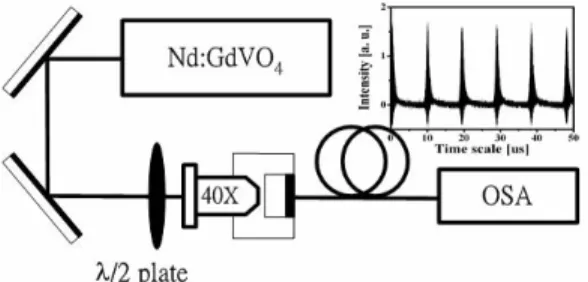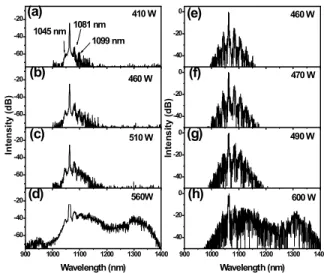Abstract—An effective supercontinuum generation is demonstrated by injecting picosecond self Q-switched mode-locked Nd:GdVO4 laser pulses into an 1 m long
microstructured fiber (MF) near the longer zero-dispersion wavelength of the dual zero-dispersion points.
I. INTRODUCTION
S
upercontinuum (SC) generation from microstructure fibers (MFs) are widely reported due to their high nonlinear coefficient and tunable dispersion [1]. The higher peak power is the key factor for the spectral broadening in MFs. However, the peak power is considerably low in CW mode locking (CML) picosecond lasers. In use of 10 ps mode-locked pulses operated in the anomalous dispersion region, the SC generation were demonstrated spanning from 700 nm to 1600 nm [2]; however, relatively high average power of 2.4 W had to be used. The SC can even be generated by 600ps Q-switched pulses that shows the suppression of the cascading Raman effect and results in the flatten spectrum in the visible region [3]. Using the cavity-dumped picosecond pumping at 1064 nm [4], the SC generation had also been demonstrated using MFs longer than 3m. In this paper, we use a self-Q-switched ML Nd:GdVO4 laser to effectively generate SC from an 1m long MF with dual zero-dispersion wavelengths. The results were also compared with numerical simulation based on the generalized nonlinear Schrödinger equation (NSE).II. EXPERIMENT SETUP
Figure 1 shows the experiment setup of SC generation using a self Q-switched mode-locked (QML) Nd:GdVO4 laser as the injecting source into a 1-m-long polarization maintained MF by a 40X microscope objective lens. The Nd:GdVO4 laser is
Manuscript received. This work is partially supported by the National Science Council of Taiwan, Republic of China, under grant NSC-93-9112-M-009-035 and NSC-93-2215-E-390-003. One of the authors, J. -H. Lin, would like to thank NSC 94-2811-M-009-028 for providing Postdoctor fellowship.
Ja-Hon Lin and Wen-Feng Hsieh are with the Department of Photonics and Institute of Electro-Optical Engineering National Chiao Tung University 1001 Tahsueh Rd., Hsinchu 300, Taiwan (e-mail: wfhsieh@nctu.edu.tw).
Kuei-Huei Lin is with Department of Science Education, Taipei Municipal University of Education1, Ai-Kuo West Rd., Taipei, 100 Taiwan (e-mail:
khlin@tmue.edu.tw)
mode-locked by the SESAM. By properly tuning the cavity length and the pump power, the laser can produce stable QML pulses (see inset of Fig. 1) at center wavelength 1062.9 nm that is located in the anomalous dispersion region of the MF. The Q-switched pulse has width of about 1 µs (FWHM) and a repetition rate of 83.3 kHz. The giant Q-switched pulse contains 100 mode-locked (ML) pulses with FWHM of 10 ps, because the time spacing of the ML pulse train is 8 ns. A λ/2 plate is positioned after the exciting laser to change the polarization of the injected light before the MF. Finally, we measured the output spectrum from MF by an optical spectrum analyzer (Ando, AQ-6315).
The used nonlinear MF (PM 760, crystal fiber inc.) has the
core diameter about 1.7µm and the pitch Λ (spacing between adjacent holes) about 1.4µm. The fiber has two zero dispersion points at 760 nm and 1160 nm (from specification). Using the SEM image as the input to the software “Mode Solutions”, we can calculate the dispersion curve as well as the mode pattern for this MF. Our simulation result shows that the two zero-dispersion points are located at 790 nm and 1190 nm which slightly differ from the provided specification. This may be due to the distortion from the shadows around the air holes in SEM. The parameters of the dispersion are obtained from the dispersion curves and are listed in Table. 1.
II. RESUTLS AND DISCUSSION
Fig 2.(a)-(d) shows the evolution of spectral broadening from the OSA as the average power of injected laser increasing from 160 mW to 220 mW that corresponds the peak power from 430W to 580W. At the peak power of 480W, some discrete peaks at 1045 nm, 1081 nm and 1099 nm appear on top of the broadening spectrum in Fig. 2(a). These discrete peaks are resulted from the MI [2], if peak power is large enough that corresponds to the Stokes and anti-Stokes components with
Supercontinnum Generation in a
Microstructured Optical Fiber by picosecond self
Q-switched Mode- Locked Nd:GdVO
4
Laser
Ja Hon Lin, Kuei-Huei Lin and Wen-Feng Hsieh
Fig. 1. Experimental setup and cross sectional scanning electron microscope image of the microstructured fiber.
689 WCC4
16:30 – 16:45
frequency shift νn = ± Ωn / 2π with respect to the pump one [10, 13]. Here, ,..., , n , ) P ( n n 1 2 2 12 2 0 = = βγ Ω (1)
and γ=(n2ω0/cAeff) is the nonlinear coefficient. Due to the relative small core diameter, very large value of γ in our MF is about 74 km-1⋅W-1 around the 1064 nm. The frequency shifts of the first two harmonics ν1 (1045nm, 1081 nm)and ν2 (1099 nm) relative to the pumping (1062.9 nm) in Fig. 2(a) are 4.8 THz and 9.2 THz that can be estimated by the Eq. 1 with P0 = 460 W
and β2 in Table 1. However, the amplitude of peak at 1045 nm is smaller than the 1081-nm one due to the Raman gain. Similarly, only the peak at 1099 nm (Stoke) can be seen that corresponds to the second order frequency Stokes shift ν2 but no anti-Stokes component. While the gain exceeds the threshold power for Raman amplification, the Stokes components within the Raman band are amplified [8]. The amplified Stokes components can be regarded as the pump induces the second or the even higher Stokes components. Therefore the spectrum shifts to the longer wavelength. The red-shift of spectrum suppresses the gain of anti-Stokes components and results in only one anti-Stokes component on the right side of the pump. As average power increasing, the Raman-effect becomes more obvious and makes the spectrum move toward the longer wavelength [see Fig. 2(b) to Fig. 2(c) at 500 W]. Figure 2(d) shows the spectrum spans from 900 nm to 1400 nm at 220 mW pumping power (or the peak power of 560 W). Once the spectrum extends exceeding the zero-dispersion wavelength, an additional spectral component would be generated at 1315 nm as a dispersive wave (Fig 2. (d)). This is resulted from the perturbation of the third order dispersion β3
near the zero-dispersion point. The third order dispersion offers phase-matching to make the energy of the pump possible to be transferred to the dispersive wave.
In this paper, we solve the nonlinear Schrödinger equation (NSE) [5] to understand the mechanism leading to the SC generation. Generally, the NSE can be divided into two parts: the dispersion with time derivative terms on the left-hand side and the nonlinear effects on the right of the equal sign. We dealt the propagation with the dispersion effect in frequency domain and the nonlinear effect in time domain, respectively, by the split-step method. The total 215 points (each time spacing 120/215) in a 120 ps time window were used in our simulation that correspond to the wavelength window from 716 to 2059 nm. For comparing with the experimental results, we chose 1 m total propagation length of pulse in MFs with each step ∆z of 50 µm.
The evolution of SC generation in our simulation is shown in Figs. 2(e)-(h) that reveals the very similar route as the experiment results. At the lower pumping, we see the spectral broadening resulting from SPM and MI, where the discrete
peaks are located symmetrically on both sides of the pumping. However, the peaks at the longer wavelength have the stronger amplitude. As the peak power increases, the spectrum further extends toward the longer wavelength by the Raman effects. Finally, the dispersive wave can be seen in Fig. 2(h) as the broadened spectrum exceeds the zero dispersion.
IV.CONCLUSION
A picosecond self Q-switched mode-locked Nd:GdVO4 laser can be used to effectively generate supercontinuum radiation in 1 m long microstructure fiber with dual zero-dispersion points as the pumping wavelength chosen close to the longer zero-dispersion wavelength. The supercontinuum generation from 900 nm to 1400 nm was demonstrated. The nonlinear effects such as modulation instability and stimulated Raman effect together with the third-order dispersion sequentially predominates the SC generation as the pumping power increases.
REFERENCES
1. J.C. Knight, J. Arriaga, T.A. Birks, A. Ortigosa-Blanch, W.J.
Wadsworth, P. St.J. Russell, “Anomalous dispersion in photonic crystal fiber,” IEEE Photon. Technol. Lett. Vol. 12, pp. 807-809, July 2000.
2. M. Seefeldt, A. Heuer and R. Menzel, “Compact white-light source
with an average power of 2.4 W and 900 nm spectral bandwidth,” Opt. Commun. Vol. 216, pp.199-202, Feb. 2003.
3. P.-A. Champert, V. Couderc, P. Leproux, S. Février,V. Tombelaine, L. Labonté, P. Roy and C. Froehly, “White-light supercontinuum generation in normally dispersive optical fiber using originalmulti-wavelength pumping system,” Opt. Exp. Vol. 12, pp. 4366-4371, Sep 2004.
4. S. Coen, A.H.L. Chau, R. Leonhardt, J.D. Harvey, J.C. Knight, W.J.
Wadsworth, and P. St.J. Russell, “White-light supercontinuum with 60 ps pump pulses in a photonic crystal fiber,” Opt. Lett. Vol. 26, 1356-1358, Sep. 2001.
5. G. P. Agrawal, Nonlinear Fiber Optics, London, Academic Press, 2001, ch1. -60 -40 -20(a) 410 W 1081 nm 1099 nm 1045 nm -40 -20 0(e) 460 W -60 -40 -20 (b) 460 W -40 -20 0 (f) 470 W -60 -40 -20 (c) 510 W -40 -20 0(g) 490 W 900 1000 1100 1200 1300 1400 -60 -40 -20 In te n sit y ( d B ) Wavelength (nm) (d) 560W 900 1000 1100 1200 1300 1400 -40 -20 0 In te n s it y ( d B ) Wavelength (nm) (h) 600 W
Fig.2 The evolution of spectral broadening in the experimental at peak power pumping of (a) 410W, (b) 460W, (c) 510 W and (d) 560 W and in the simulation results at (e) 460 W, (f) 470 W, (g) 490W and (h) 600W.
TABLEI Parameters of dispersion at 1064 nm β2 (ps2/km) (psβ3 3/km) (psβ4 4/km) Β*10 -6 (ps5/km) β6 *10 -8 (ps6/km) -57.79207 -0.08328 0.00153 -9.20867 5.66594 690

